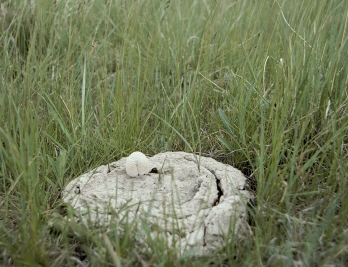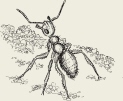
So, despite everything we’ve heard to the contrary, the presence of earthworms in the soil is not always a mark of good health. Across much of the Great Plains, it is a prime indicator of disturbance. In arid regions, the work of digesting organic matter is assigned by nature not to tender worms but to the invincible legions of drought-hardy microorganisms. Meanwhile, an unlikely consortium of animals has taken on some of the earthworm’s other tasks. For instance, the job of turning the soil—digging in dead vegetation from the surface and bringing up clay from below (a service that is provided by earthworms where they are plentiful)—is here performed by burrowing mammals, including ground squirrels, pocket gophers, prairie dogs, and badgers, and most notably by ants. Given their impact on prairie soil, it could almost be said that ants are the earthworms of the Great Plains grasslands.
There are dozens of different species of ants on the prairies (eighty-three, for example, in North Dakota alone), and while they differ in many particulars—size, color, diet, habitat—they tend to have one characteristic in common. Unlike ant species elsewhere that may take shelter in rotten logs or inside rolled-up leaves, most of the ants on the grasslands nest in the soil. An anthill is merely the visible extension of a complex of tunnels that extends down through the topsoil and into the subsoil beneath, often to a depth of 3 to 6 feet (1 to 2 meters). The labor of excavating these underground runways and lugging the soil up, grain by grain, can occupy a colony of several thousand ants for the better part of a decade.

Formica inserta
But this Herculean effort is justified by the benefits that accrue to the ants. Like all insects, ants are ectothermic, or cold-blooded. In other words, they assume the temperature of their surroundings and regulate their body heat by seeking shade or sunlight, as required. By constructing their complex, multilevel dwellings, ants alter their environment to create a range of microhabitats, each with its own particular microclimate. In winter, for example, they may retreat to their deepest chambers (below the reach of the frost), where they shuffle groggily through the coldest months. In summer, some species make sophisticated use of their anthills, which are carefully angled to soak up rays from the sun. As heat builds up in the hill, crews of workers lug their larval brood from place to place inside, striving to keep both themselves and their charges at just the right temperature.
As ants manipulate their surroundings to meet their own needs, they inadvertently replenish the soil. The particles of clay that they carry up from their basements are rich in the minerals needed by plants and thus help to maintain the fertility of the upper layers. One estimate suggests that the top 2 feet (60 centimeters) of prairie soil is turned over every hundred years through the infinite efforts of ants and other soil creatures. And all this is achieved without any attention from us, beyond the farthest horizons of our senses.
> DUNG BEETLES
Death by desiccation is a threat to many insects, particularly to the soft-bodied, unprotected larvae. One way to avoid this hazard is to take shelter underground, away from the drying effects of the wind and sun. This need for protection from the elements explains why so many fly and beetle larvae—maggots, wireworms, and grubs—are found in the soil, within wriggling reach of subsurface moisture.
As a rule, the adult forms of these insects are not attentive parents: they simply lay their eggs in the soil and leave the larvae to look after themselves, as they grow, pupate, and eventually take wing as a new generation. Not so the members of the family Scarabaeidae, or dung beetles. Despite what may seem a lowly station in life as eaters of excrement, dung beetles are sophisticated insects that invest in parental care by providing their offspring with food, moisture, and shelter. On the Great Plains, the 100 or so species of dung beetles accomplish this task in one of four ways. First, there are the “rollers,” largish beetles (up to an inch, or 3 centimeters, in length) that cut chunks of moist dung from a bison or cow pat and use their forelegs to form it into a ball. Then, engaging their hindlegs and walking backwards, they shove the ball through the grass until they find a suitable place to bury it. In this underground nursery, the female lays an egg inside the ball of dung, which will provide sustenance and protection for the larva.
The second group, the “tunnelers,” follow a similar strategy. But instead of struggling to transport the dung cross-country, these species (which tend to be smaller than the rollers) simply chew out chunks of dung and dig them directly down in the dirt, either under or beside the dung pat. Here again, the female lays her single egg inside the lump of dung, which will be the larva’s only source of sustenance during its two-to-three-week period of metamorphosis.
Then there are the “dwellers”—the smallest of the lot—which take an even simpler and less laborious approach. Rather than carrying dung down into the soil, they lay their eggs right inside the pat. Because dung pats dry out quickly, these insects have a short reproductive cycle, which speeds them from eggs to adults in a few days’ time.

Cow pat with fungus
Candace Savage photo
Finally, there is a unique group of pat-dwelling beetles that, over the last ten thousand years, have become adapted to eat rodent dung and to live in the cool, moist environment of rodent burrows. Some of these species are at home in open-mouthed burrows, like those made by ground squirrels and black-tailed prairie dogs, while others are found exclusively in the closed burrows of pocket gophers. On the rare occasions in spring and fall when the pocket gophers open up their dens, the air is sometimes peppered with thousands of tiny dung beetles making their escape, as they search for new burrows and fresh opportunities.
Bite by bite, dung beetles and dung-beetle larvae process enormous amounts of organic matter and make an incalculable contribution to the fertility of the soil.
> AN ASTONISHMENT OF ANTS
The fascination of ants extends far beyond their importance in building the soil. Although prairie ants represent only a tiny fraction of the 15,000 species that have been described around the world, they nonetheless exhibit a full range of weird and wonderful behaviors.
By and large, prairie ants are carnivores with a taste for sweets. Because they hunt in groups, they are generally the most successful predators in their size range, subduing impressive numbers of spiders and smooth- and soft-bodied insects. Prey animals are generally torn into bits and carried back to the nest, where they are fed to the larvae. The worker ants’ main source of nourishment, however, is nectar from plants. This they typically obtain from one of two sources. Many plants, including native sunflowers and partridge peas, have special glands on their leaves, stems, or buds that produce ant-sized drops of nectar. Ants come to sup at these honeyed fountains—or “extrafloral nectaries,” as they are formally known—and defend them vigorously, in the process inadvertently defending their hosts against plant-eating insects.
Ants also acquire nectar secondhand, by milking “honeydew” from the anuses of sap-eating aphids. Some ants carry on this trade in public, on the leaves of aphid-infested plants, but others prefer to milk their aphids in the privacy of the soil. Except for nuptial flights—when winged “reproductives” burst forth to mate and form new colonies—these ants spend their entire life cycle underground. Their nests feature special chambers around the roots of selected plants, where they keep their “herds” of root-feeding aphids. The ants tend their livestock constantly, tapping the aphids with their antennae to induce them to secrete sweets and slaughtering the tender young to supply their need for meat.

Lasius neoniger